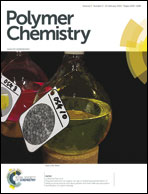Sunlight-induced crosslinking of 1,2-polybutadienes: access to fluorescent polymer networks†
Abstract
The efficient sunlight-induced crosslinking of 1,2-polybutadienes to generate fluorescent patterns with spatial resolution is reported. The photochemical conjugation method employed is based on a nitrile imine-mediated tetrazole–ene cycloaddition (NITEC) reaction, which proceeds under UV-light irradiation (λmax = 312 nm) at ambient temperature in the absence of any catalyst. The NITEC reaction between 1-pentene and a newly designed di-linker, consisting of two photosensitive diaryl-substituted tetrazoles joined by a tetraethylene glycol spacer, was investigated in an initial study. Detailed characterization of a small molecule model study was performed by size exclusion chromatography (SEC), UV-vis and fluorescence spectroscopy as well as electrospray-ionization mass spectrometry (ESI-MS), which was also employed for monitoring the progress of the reaction (100% conversion in 20 min). Finally, two 1,2-polybutadienes of disparate molar masses were each photocrosslinked with the di-linker. The crosslinking reaction parameters, such as concentration, di-linker fraction and reaction time were optimized via SEC analysis and gravimetric determination of gel fractions. The applicability of the novel crosslinking technology for generating spatially controlled highly fluorescent gel patterns is demonstrated in a solvent-free reaction for 2 h under sunlight. In summary, the current study introduces an efficient light-triggered technology platform for crosslinking polymers carrying non-activated double bonds.


 Please wait while we load your content...
Please wait while we load your content...